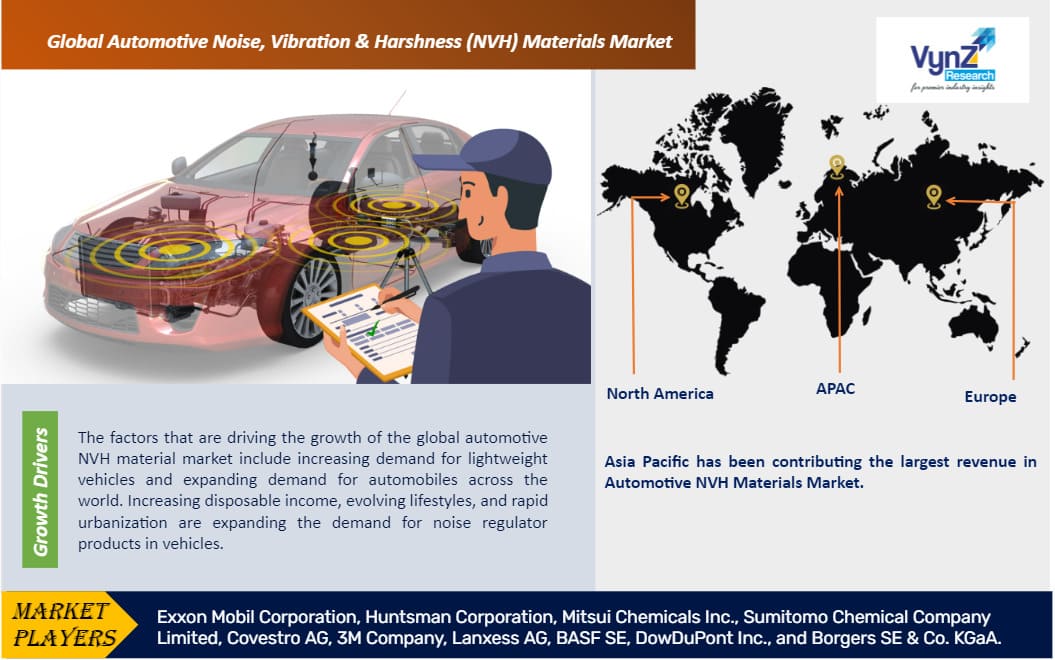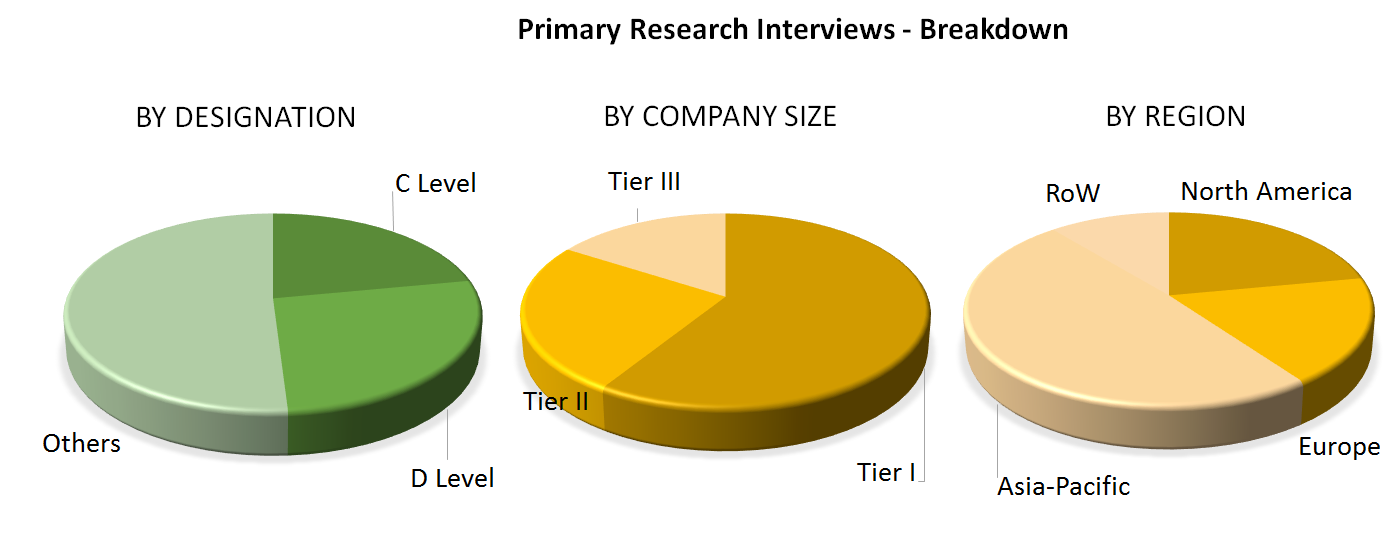| Status : Published | Published On : Dec, 2024 | Report Code : VRCH2004 | Industry : Chemicals & Materials | Available Format :

|
Page : 250 |

Global Automotive Noise, Vibration & Harshness (NVH) Materials Market - Analysis and Forecast (2025 - 2030)
Industry Insights by Type (Rubber, Foam, Metal Sheet, Cork, Polyvinyl Chloride, Felt, and Others), by Application (Vibration Dampening, Insulation, and Sound Absorption), by Vehicle Type (HCV, Passenger Vehicles, and LCV) and by Geography (North America, Europe, Asia-Pacific, Middle East, and Rest of the World)
Industry Overview
The Automotive NVH Materials Market was valued at $8.7 billion in 2023 and is estimated to reach $14.6 billion by 2030. This market is also expected to observe a CAGR of 7.3% during the forecast period. The increasing market share is attributed to extensive sales of automobiles and increasing demand for lightweight vehicles across the globe. NVH stands for noise, vibration, and harshness and it comprises a complete array of perceptions from hearing to feeling. The demand for automotive NVH materials is witnessing rampant growth as it is considered to be the most crucial part of product development.

Automotive NVH Materials Market Segmentation
Insight by Type
On the basis of type, the automotive NVH materials market is segmented into rubber, foam, metal sheet, cork, polyvinyl chloride, felt, and others. The other types are segmented into resins and fiberglass. Among all these segments, rubber has been holding the largest revenue in the global automotive NVH materials market and is expected to contribute $4.4 billion by 2030. The market is witnessing swelling demand due to its various properties such as fluid resistance, high-temperature stability, and low cost of rubbers thereby making it popular as compared to several types of automotive NVH materials. Moreover, the extensive demand for rubber is attributed to its incomparable properties in automotive applications such as noise insulation and vibration damping.
Insight by Application
On the basis of application, the automotive NVH materials market is segmented into vibration dampening, insulation, and sound absorption. Among these applications, sound absorption application is expected to witness the fastest growth, registering a CAGR of 8.3% during the forecast period in terms of value. The growing demand for this application is accredited to a large number of complaints observed for undesirable noise from vehicles across the globe. The use of sound-absorbing applications helps automotive manufacturers enhance and improve consumer satisfaction and provide them comfort in all aspects. Furthermore, this is expected to propel the growth of the automotive NVH materials market across the globe.
Insight by Vehicle Type
The automotive NVH materials market on the basis of vehicle type is segmented into heavy commercial vehicles (HCVs), passenger vehicles, and light commercial vehicles (LCVs). Among all these segments, passenger vehicle has been contributing the largest revenue of more than 70.0% in 2017. The incorporation of several safety regulations by government agencies across the globe along with increasing demand for passenger vehicles is driving the growth of passenger vehicle type in this market across the globe.
Global Automotive NVH Materials Market Report Coverage
|
Report Metric |
Details |
|
Historical Period |
2018 - 2023 |
|
Base Year Considered |
2024 |
|
Forecast Period |
2025 - 2030 |
|
Market Size in 2024 |
U.S.D. 8.7 Billion |
|
Revenue Forecast in 2030 |
U.S.D. 14.6 Billion |
|
Growth Rate |
7.3% |
|
Segments Covered in the Report |
By Technology, By Vehicle Type, and By Application |
|
Report Scope |
Market Trends, Drivers, and Restraints; Revenue Estimation and Forecast; Segmentation Analysis; Impact of COVID-19; Companies’ Strategic Developments; Market Share Analysis of Key Players; Company Profiling |
|
Regions Covered in the Report |
North America, Europe, Asia-Pacific, Middle East, and Rest of the World |
Industry Dynamics
Automotive NVH Materials Market Growth Drivers
The factors that are driving the growth of the global automotive NVH material market include increasing demand for lightweight vehicles and expanding demand for automobiles across the world. Increasing disposable income, evolving lifestyles, and rapid urbanization are expanding the demand for noise regulator products in vehicles. It has been observed that people across the globe are more inclined towards eco-friendly, lightweight, and comfortable vehicles. Moreover, the swelling production of vehicles is bolstering the market growth for automotive NVH materials globally.
Automotive NVH Materials Market Challenges
The availability of additional products that alleviate NVH in automobiles is hindering the growth of the automotive NVH materials market globally. These materials are expansively being used to decrease excessive noise and vibrations from vehicles. Moreover, the availability of various substitutes such as advanced active noise control systems, which use less manual input and avoid the diffusion of vibrations and excessive noise to passenger cabins. Furthermore, these factors are hindering the growth of automotive NVH materials globally.
Recent Developments By the Key Players
LANXESS, Specialty chemicals company will offer a highly sustainable variant of its Bayferrox iron oxide yellow pigment in the future. The pigments marketed under the company’s own Scopeblue label have a significantly reduced carbon footprint thanks to the use of more eco-efficient raw materials. This reflects the growing awareness of the raw material product carbon footprint (PCF) in the paint and coatings industry and the resulting demand for sustainably manufactured pigments.
Sumitomo Chemical has acquired all shares of Philagro Holding, S.A. which is its France-based consolidated subsidiary engaged in sales of crop protection products.
Automotive NVH Materials Market Industry Ecosystem
Globally industry players are leveraging market growth through the adoption of several growth strategies that include joint ventures, acquisitions, and new product development. The key players operating in this market such as Sumitomo Riko Company Limited (Japan) and the Dow Chemical Company (U.S.), have implemented various organic and inorganic expansion plans to accelerate their business growth.
Automotive NVH Materials Market Geographic Overview
Geographically, Asia Pacific has been contributing the largest revenue and is expected to generate $6.2 billion by 2030. The largest share of this market is accounted towards the increasing usage of automotive NVH materials in passenger vehicles particularly in countries such as India and China. Moreover, the growth of this market in this region is due to growth in the automotive industry which is enhancing the demand for automotive NVH materials. Furthermore, it has been observed that in North America, the U.S. holds the largest market for automotive NVH materials and this domination is anticipated to endure during the forecast period.
Automotive NVH Materials Market Competitive Insight
- Exxon Mobil Corporation
- Huntsman Corporation
- Mitsui Chemicals Inc.
- Sumitomo Chemical Company Limited
- Covestro AG
- 3M Company
- Lanxess AG
- BASF SE
- DowDuPont Inc.
- Borgers SE & Co. KGaA
The Automotive NVH Materials Market report offers a comprehensive market segmentation analysis along with an estimation for the forecast period 2025–2030.
Segments Covered in the Report
- Type
- Rubber
- Foam
- Metal sheet
- Cork
- Polyvinyl Chloride (PVC)
- Felt
- Others
- Application
- Sound Absorption
- Insulation
- Vibration Dampening
- Vehicle Type
- Passenger Vehicles
- LCV
- HCV
Region Covered in the Report
-
North America
-
U.S.
-
Canada
-
Mexico
-
Europe
-
Germany
-
U.K.
-
France
-
Italy
-
Spain
-
Russia
-
Rest of Europe
-
Asia-Pacific (APAC)
-
China
-
Japan
-
Vietnam
-
India
-
South Korea
-
Rest of Asia-Pacific
-
Middle East and Africa (MEA)
-
UAE
-
Saudi Arabia
-
South Africa
-
Rest of MEA
-
Latin America
-
Argentina
-
Brazil
-
Chile
-
Rest of LATAM

Source: VynZ Research
Frequently Asked Questions
Purchase Options
Latest Report
Research Methodology
- Desk Research / Pilot Interviews
- Build Market Size Model
- Research and Analysis
- Final Deliverabvle
Connect With Our Sales Team
- Toll-Free: 1 888 253 3960
- Phone: +91 9960 288 381
- Email: enquiry@vynzresearch.com
Automotive NVH Materials Market
